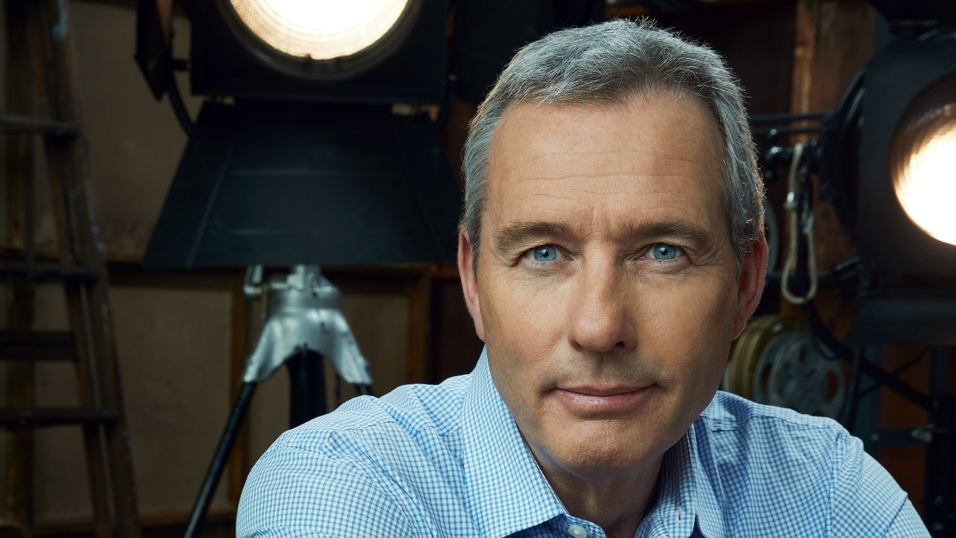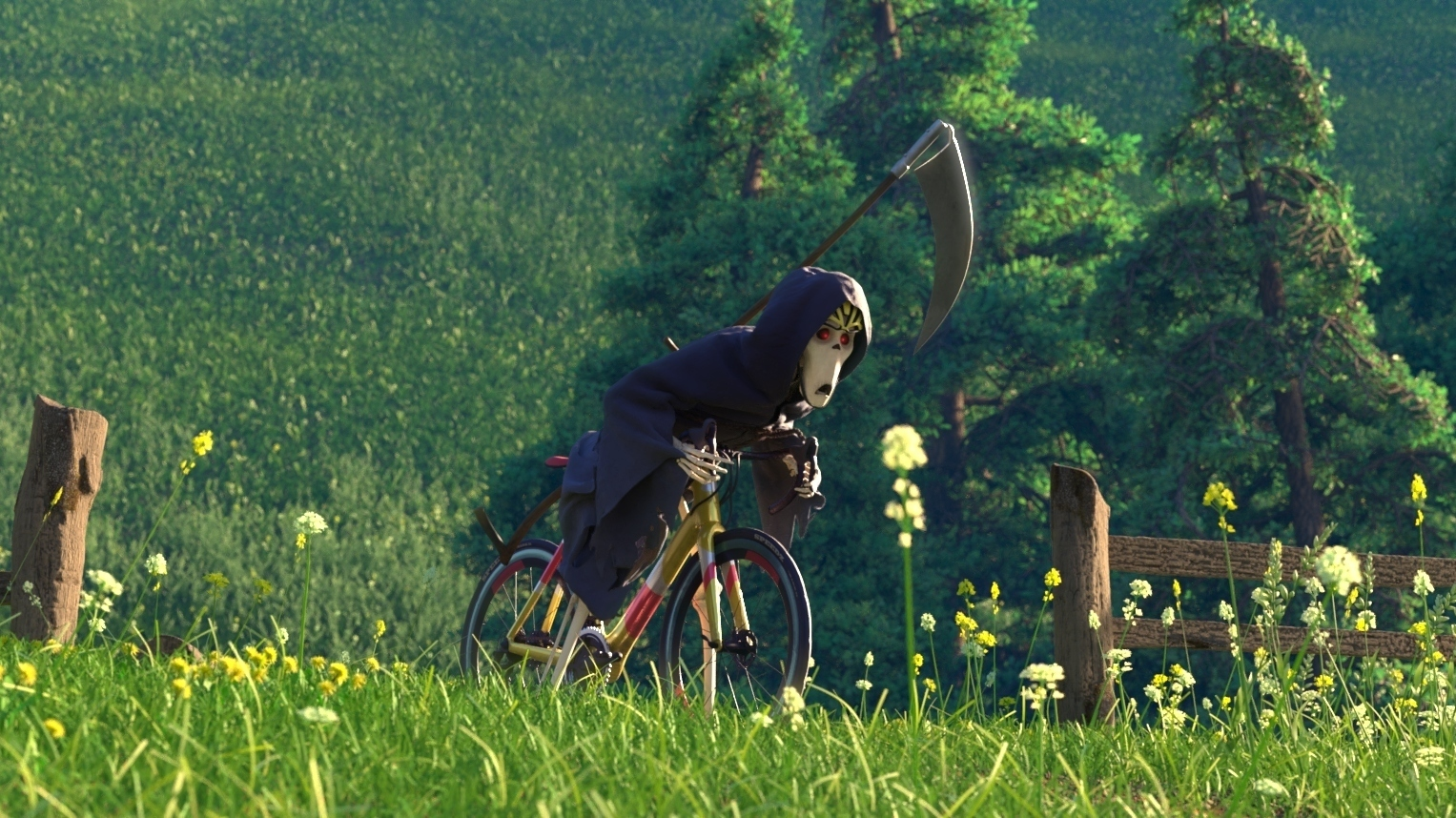Layout Supervisor Terry Moews has been at Walt Disney Animation Studios for nearly twenty-five years, joining in 1995 with a background in live-action filmmaking to assist with “The Secret Dinosaur Project.” As you might imagine, he’s worked on a huge list of films and shorts and has seen the studio go through some pretty big changes leading up to his directorial debut with The Race, part of the Short Circuit experimental film program. It was an honor to interview Terry during a recent visit to the animation studio in Burbank.
Alex: We’ve seen the grim reaper and visual representations of death in a number of things. What were your intentions with making this grim reaper different than anything we’ve ever seen before?
Terry Moews: Well the first big thing is that he has a regular job. He’s got a job just like we do, he has the pressures of a job and that’s at the crux of the two themes of the film. He’s got a job to do and his job is death, but our protagonist very much wants a little more life because he finally has the epiphany of what’s important. So I thought it’s really fun to pit those two themes against each other because we view the story through death. We call him Grimm, we view it through Grimm and like I said, he’s a regular guy who’s got pressures and so what ends up happening is he ends up with the same epiphany that our protagonist does. That’s what makes him different.
Alex: Was there anything in the real world that inspired the quota counter that he has?
Terry: No, that was purely a created invention so that he would earn his ending, he would earn that. If he didn’t have anything to gauge it against it could’ve been oh well, there’s no reason not to take the guy at the end. He had to have something to be in conflict with and it’s also a double metaphor of the cup. The cup is the metaphor in the race. At the end of the race, is it the cup that’s important? In the race of life, you can have the cup or you can have all that was important to you. As my father said, ‘I don't think on my deathbed that I’m going to wish I had spent another day at the office.’ He should’ve spent another day out fishing or playing with his kids or doing something. And so if there hadn’t been the countdown, he couldn’t have gotten to that moment. The countdown symbolizes all the pressures and responsibilities of a working person and everything that comes with it. So we had to have something to cause that catalyst.
Alex: This film is going to read differently depending on where you are in your life or what’s going on in the lives of those around you, particularly people going through cancer. Is that something that was in your mind as you were developing the project?
Terry: Very much. I am older, especially compared to most of the people at the studio, and it’s not something I dwell on but these things become more important. A day off with my kids becomes vastly more important than it would have in my twenties. I think there are some things that you take for granted both personally and professionally when you’re younger that you don’t when you’re a little bit older. I did want to high mindedly have some sort of prophetic wisdom, if I can be so bold as to say that, to pass on and to have as the foundation of this. I’m happy and I hope that it reads differently for different generations and people bring into it. But the message is the same that I would want to tell which is look, in this race we call life, what is important? Is it the cup or is it the relationships and the things that we’ve had along the way?
Alex: Despite the heavy themes, the film plays very lightly. Were there a lot of discussions about the right balance of comedy in a story about the meaning of life?
Terry: It’s funny that you say that. The original version of the story was told from the racer’s point of view and so it didn’t have that comedy. I always wanted the cat and mouse, the sort of coyote/roadrunner, I always wanted that because it suited the action of the film. When we flipped it, kind of made it through death’s eyes, that’s where we found the comedy, funny enough. That’s where we found the comedy because again, in making him a regular joe, he became just like the racer and that’s what he realizes in the end. I am just like him. And so it was easy to come up with the comedy, it was easy to look at the comedy element. So in reality, I’m going to answer your question backwards, it was easy to construct the comedy and construct the overall conflict and then it was really about going back and then finding and inserting these other moments to make sure that that came through and balanced out just the abject comedy of it all.
Alex: You started at Disney Animation at a time when the industry took a left turn. What has that evolution been like and how would you compare the studio today to what it was in the early 2000’s?
Terry: When I came here, it’s always been a very friendly, very warm, very wonderful place to come to work. Someday when I ever retire, I will miss it terribly and what I will miss is all my friends here. This is a second family and it has been for quite a while. We used to be a lot more department centric than we are and largely I have to say it’s the medium that we work in. When it was more of a 2D environment, it really was about artists being in their office with the door closed focusing on drawing all of the stuff that they had to draw or inking or painting or planning all of the stuff that had to happen. When I first started here, it was very much molded in that vein. Modelers did their task and went home, layout did their task and went home. And we all kept kind of throwing stuff over the wall and really I have to give credit to John Lassiter coming in and saying look, there’s a deeper way for this to work. And to that end, as the head of the Layout Department, we have a great department and we’ve embraced this idea of trying to break down these departmental walls. And one of the big aspects of that is saying look, in the filmmaking process, a good idea can come from anybody. It doesn’t have to come from our leaders and so that’s where the studio has really culturally evolved and changed is embracing that idea that we’re all capable of being deeply connected and part of our film up and down. And it is light years from where it was. Still a great place to work then, but an exponentially greater place to work now and part of it, I don’t want to belabor the question, also computers help you do that, believe it or not. And all of the trends that we look for in how our pipeline wants to work with computers is the ability to see what anybody is doing at any one time. To be part of the creation process instead of this very departmentric where I finished my part, now you’re going to do your part, and then when you’re done you will pass on to the next person. Collaboration and openness amongst the whole building and even the design of the new building is about that. Is about opening up spaces and walls and communication and it’s just paid off huge. What we can accomplish both artistically and technically has just made leaps and bounds.
Alex: As the Head of Layout becoming the director of a short, do you feel like you were better prepared to handle this responsibility having already been in a leadership role?
Terry: To be honest, I never felt any trepidation or dread, I just had the best time. I was A, itching for my opportunity and being here for so long, you get to meet a lot of people and form a lot of relationships. And one of the things I try to do as a director is just invite everybody in and that was the point. Like in layout, when we would look at the film I would just turn to all the Layout Artists and just say what are we doing wrong? What are we doing right? What haven’t we done? And it was really about everybody contributing and making them feel like this movie was just as much theirs as it was mine and I just had fun, to be honest, I just had fun. I never once stopped to say the pressure that I’m under or whatever. It was just fun and I think everybody had fun doing it. Our president at the time, Andrew Millstein, asked me that very same question and I think he was a little taken aback when I said I was just having fun. And it is, in my twenty-five year history, that was the four most fun months of my time here and they’ve all been fun.
Alex: There’s a particular moment in this that really reminds me of Tex Avery where Grimm is on the bike and smoke billows around him and his eyes pop off the screen. Is Tex Avery’s style something that you were trying to bring back?
Terry: Totally. It was Tex Avery, it’s been a number of things that I’ve seen since then. It’s a callback to sort of an iconic moment but a fun but powerful moment. That’s what Tex Avery was so incredible about is he got all this great… he captured so much in his wonderful animation style and moment that he had and everybody could relate to it and that was the thing, we wanted that transformation to be, again, economy was our word every day. I had to do something in one shot that I’d normally do in three and so I had one crack at it. We brought Tex Avery in, we looked at some of the Warner Bros. stuff, most importantly some of the stuff with Bugs Bunny. I forget the title of it at the moment but there’s a wrestling one that’s great. It was all of that, but Warner Bros. was definitely kind of our muse.
Alex: My last question is about the final moment of the short when Grimm is turned away by his wife or baby mama, were you trying to speak to anything about karma or what he had done in the past leading up to that?
Terry: To be honest, not initially. It was just fun, it was a fun button. I was searching for a button to put on it and it was just a very fun thing. As a dad, I’ve been there in that moment and so I wasn’t trying to reach for anything more than that.
Terry Moews’ The Race and other Short Circuit films are now streaming on Disney+.


